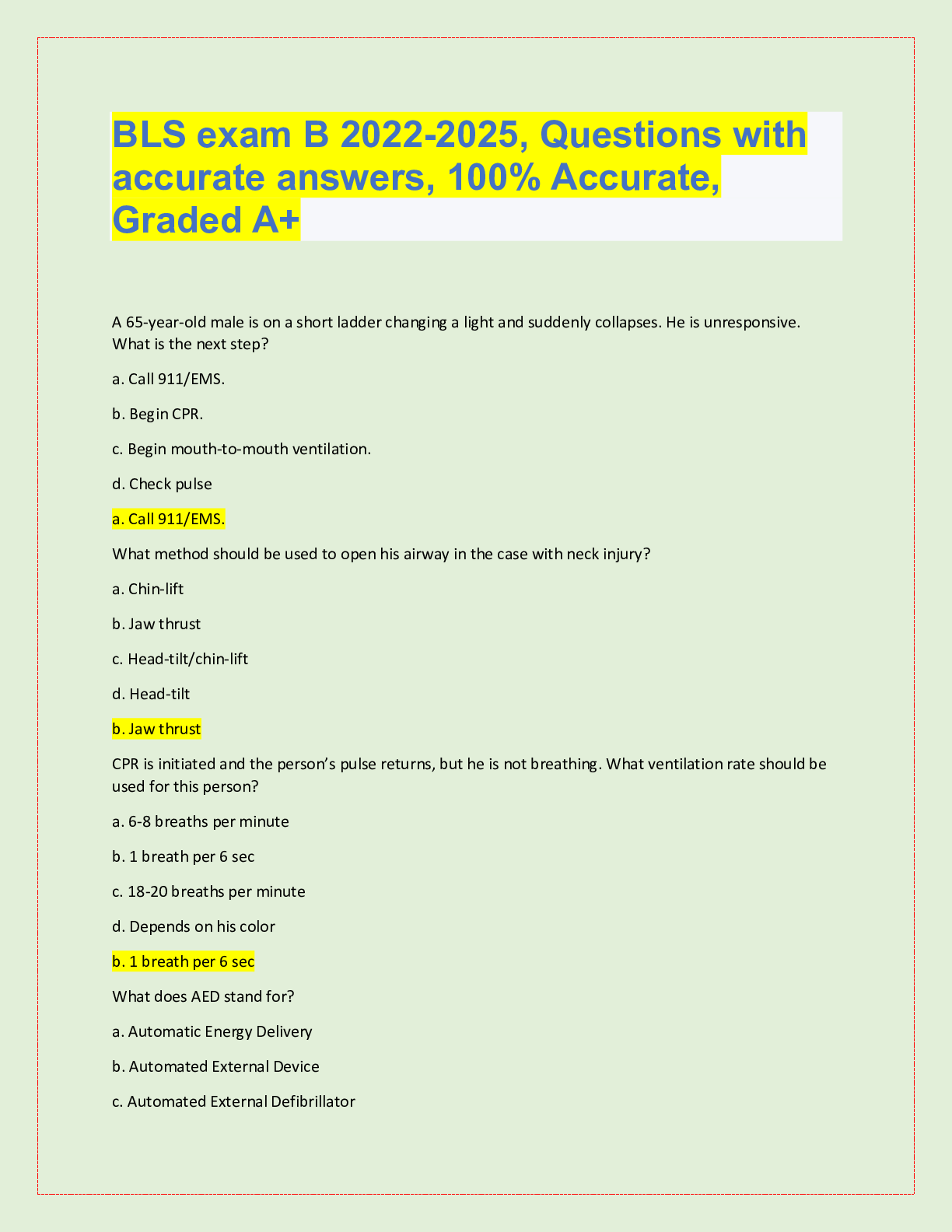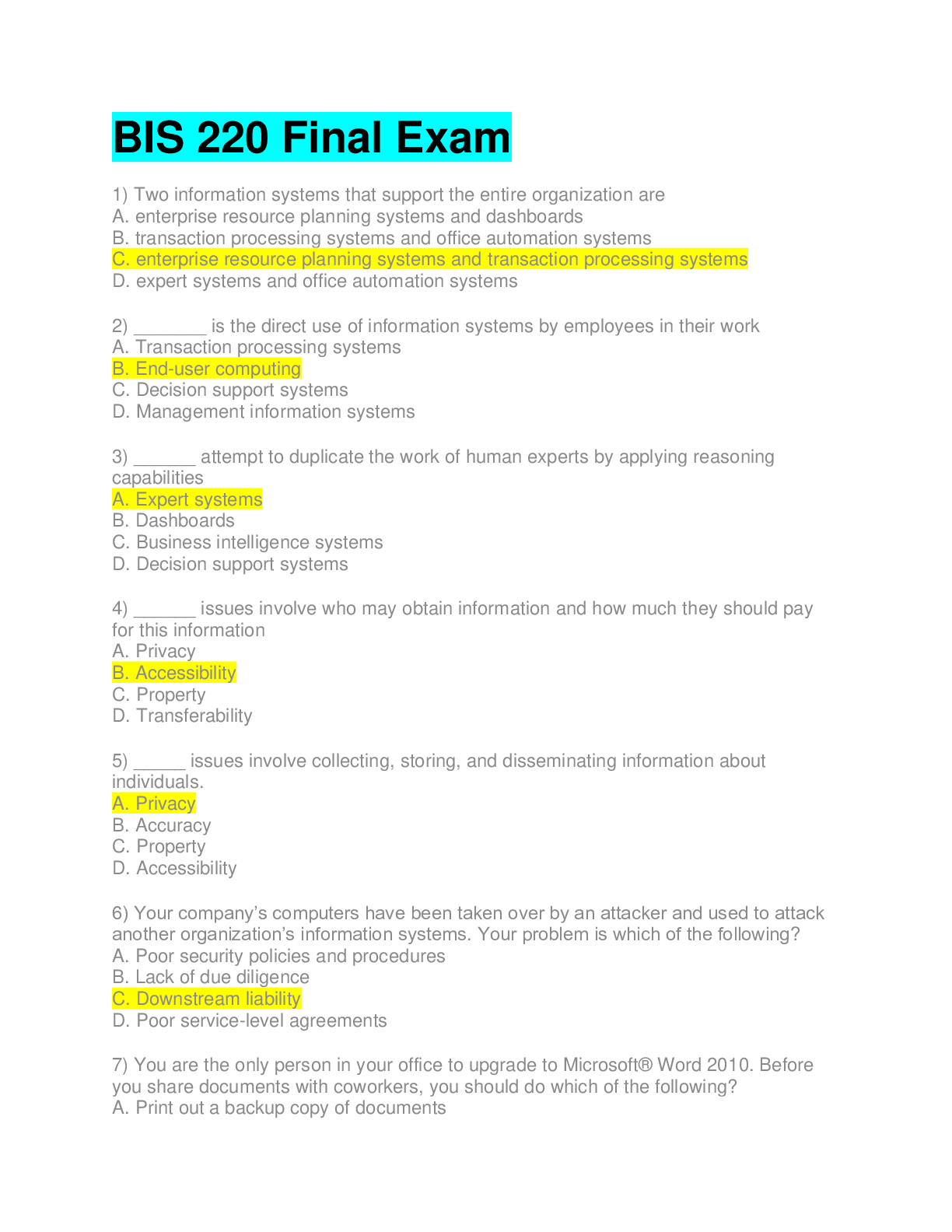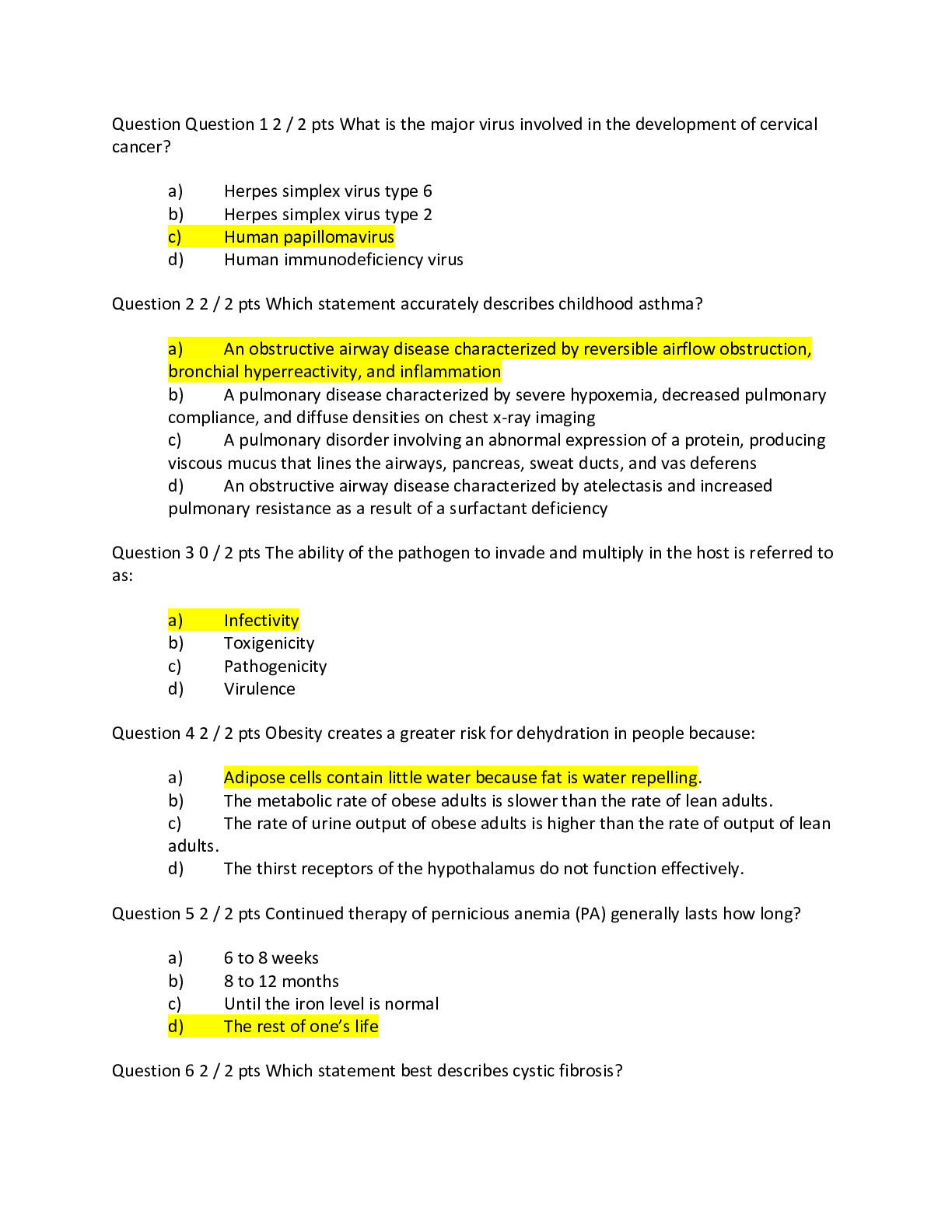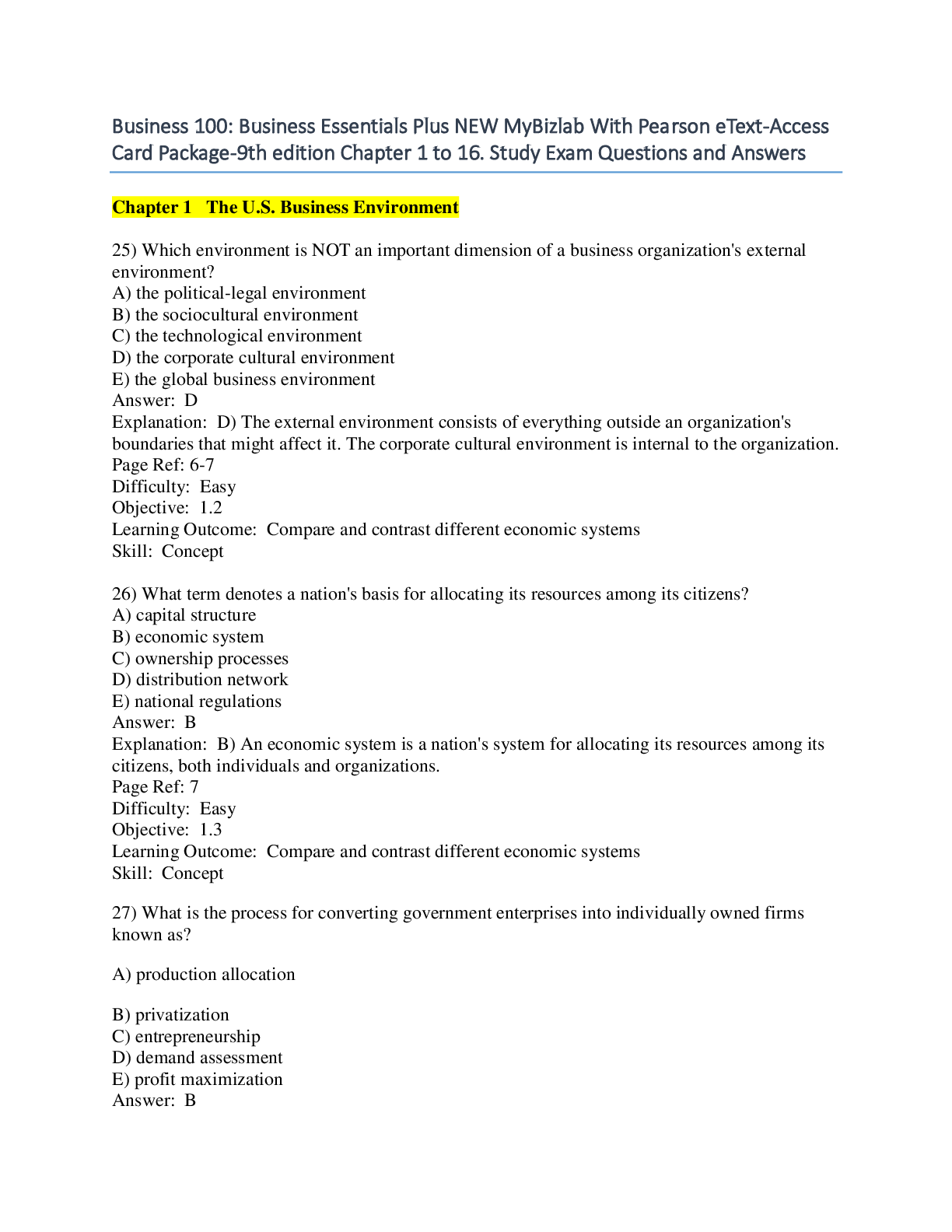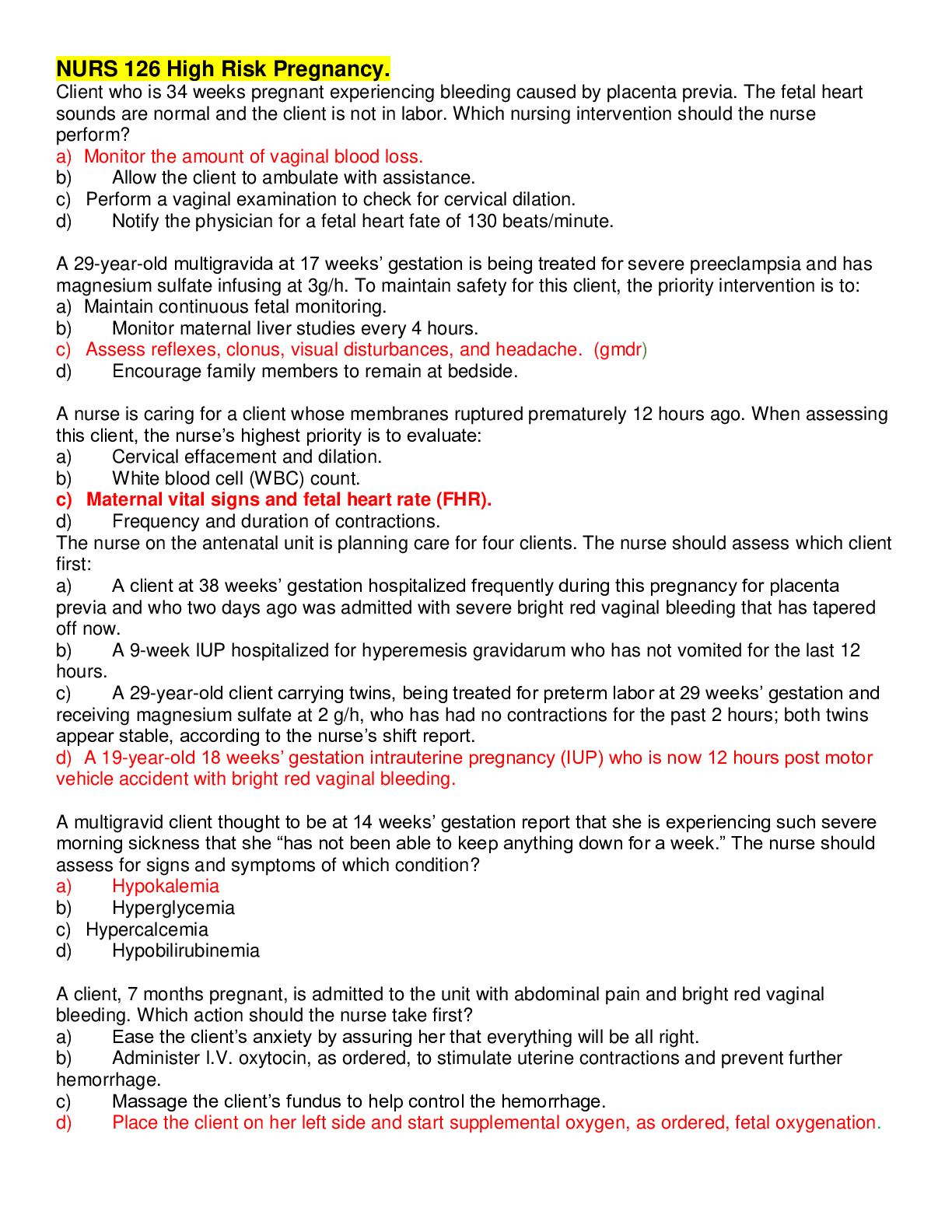Health Care > QUESTIONS & ANSWERS > NCAC II Exam Questions Bank.Questions and answers, 100% Accurate, graded A+ (All)
NCAC II Exam Questions Bank.Questions and answers, 100% Accurate, graded A+
Document Content and Description Below
NCAC II Exam Questions Bank.Questions and answers, 100% Accurate, graded A+ Pharmacology - ✔✔-the branch of science that examines how psychoactive substances taken to alter bodily functions... or enhance bodily functions interact with the brain and body. Due to it's short half-life, which requires a divided dosing? - ✔✔-Wellbutrin The first stage in group process may be referred to as: - ✔✔-Dependency The ICRC/AODA defines assessment as: - ✔✔-An identification of the client's strengths, weaknesses, needs and problems to develop the treatment plan. In regard to crisis situations, the most useful criterion for evaluating the effectiveness of actions taken between sessions is: - ✔✔-Level of functioning, compared to pre-crisis level The Cephalocaudle Principle - ✔✔-Development proceeds from the head downward, with control over the head and face first, then the arms, and finally the legs. Within two months from birth infants develop control over head and face movements. In the following few months, they are able to use their arms to lift themselves up. Control over the legs develops between 6 to 12 months of age, with infants then able crawl, stand, and eventually walk. Arm coordination always precedes leg coordination. The Proximodistal Principle - ✔✔-Development proceeds from the center of the body outward. Thus, arms develop before hands, and the fingers and toes follow. Muscle control over the fingers and toes develops last, as well. Sigmund Freud - ✔✔-Freud emphasized the significance of childhood events and experiences, but focused nearly entirely on abnormal development instead of normal functioning. Freud described child development as a set of "psychosexual stages," referred to as oral, anal, phallic, latency and genital. Erik Erickson - ✔✔-A neo-Freudian psychologist that hypothesized that people face pass through 8 social development stages from infancy to old age. Each challenge has an outcome that affects a persons social and personality development. Jean Piaget - ✔✔-Theorist Jean Piaget focused primarily on the mental aspects of childhood, and proposed a four-stage theory of cognitive development. He pioneered the idea that children's knowledge of the world is gained by active interaction, describing them as "little scientists" in this endeavor. Rational Emotive Psychotherapy - ✔✔-The earliest form of a cognitive-behaviour approach to social work practice, in which personal problems are understood to be the result of irrational patterns of thinking and the dysfunctional behaviours that happen as a result. The goal of the therapist is to help a client to see that the negative emotions experienced are due to a flawed perception of reality. Motivational Enhancement Therapy - ✔✔-a brief, nonconfrontational, client-centered therapy designed to change specific problematic behaviors such as alcohol or drug use Freudian Psychoanalytic Theory - ✔✔-based on the idea that people are influenced considerably by their unconscious, inner drives. Cognitive Behavioral Therapy - ✔✔-a popular integrative therapy that combines cognitive therapy (changing self-defeating thinking) with behavior therapy (changing behavior) Socratic Dialogue - ✔✔-A process that cognitive therapists use in helping clients empirically test their core beliefs. Clients form hypotheses about their behavior through observation and monitoring. Gestalt therapy - ✔✔-therapy that aims to integrate different and sometimes opposing aspects of personality into a unified sense of self Person Centered Therapy - ✔✔-a nondirective insight therapy based on the work of Carl Rogers in which the client does all the talking and the therapist listens Priviledge - ✔✔-refers to the right of an individual not to have confidential information disclosed in legal proceedings. Transactional Analysis - ✔✔-treatment that focuses on patterns of interaction with others, especially patterns that indicate personal problems When is privilege waived? - ✔✔-Privilege is waived in the following ways: 1) when the client has agreed that the counselor may reveal confidential information, 2) when a third person has been made privy to the information, and 3) under certain legal conditions. The therapist cannot claim privilege once the client has agreed to waive privilege. Existential Therapy - ✔✔-a therapy that encourages clients to accept responsibility for their lives and to live with greater meaning and value Informed Consent - ✔✔-requires that an individual not only provide voluntary consent, but that he or she be adequately informed regarding choices, options, and outcomes to have properly understood the meaning of the consent or refusal that was given. Typically this requires disclosure of: nature and purpose of the treatment the risks and consequences the available alternatives the risks of no treatment. Who created CBT? - ✔✔-Aaron Beck Duty to warn - ✔✔-Mental health professional's responsibility to break confidentiality and notify the potential victim whom a client has specifically threatened. Rational Enhancement Behavioral Therapy - ✔✔-based on the principle that people are not disturbed by events but rather how they see the event. Attitudes and negative self- concepts can start and maintain the process of addiction. methadone maintenance - ✔✔-a treatment program for heroin abusers in which heroin is replaced by the long-term intake of methadone Continuous Quality Improvement (CQI) - ✔✔-system of development in the workplace for daily improving performance at every level in every operational process by focusing on meeting or exceeding customer expectations Stage two of the comprehensive assessment process, screening, refers to all, EXCEPT: - ✔✔-Determining which treatment program is best for the client When conducting a psychoeducational group, the level of facilitator activity is: - ✔✔-High, with a strong focus on the leader Psychoactive Substance - ✔✔-Any drug that affects the central nervous system and alters consciousness and/or perceptions Providing therapy to clients who have a different cultural background than the therapist: - ✔✔-Requires that the therapist obtains additional training to work with diverse clients Which is NOT a symptom of Sedative, Hypnotic or Anxiolytic Intoxication? - ✔✔-Sweating or cold chills The first stage in group process may be referred to as: - ✔✔-Dependency Physiological effects - ✔✔-Physical signs and symptoms of a pscyhoactive substance A treatment plan must be in place within - ✔✔-One week Which is NOT an MAO inhibitor? - ✔✔-Elavil Suicide Risk Factors - ✔✔-More women attempt although more men commit. Questioning - ✔✔-the appropriate use of open and close-ended questions, and avoiding complex double/embedded/nested questioning. Psychological effects - ✔✔-Alterations in perception and/or judgement caused by a psychoactive substance Reflecting - ✔✔-using paraphrasing, summarizing, and feeling-based reflection. Also, reflecting values, beliefs, and key meanings. Chemical Interaction - ✔✔-Physiological and psychological effects of two or more psychoactive substances that are administered simutaneously Confrontation - ✔✔-challenging clients in productive ways to overcome denial, avoidance, misdirection, and deception, etc. Encouragers - ✔✔-the appropriate use of phrases such as "tell me more," etc., to encourage and facilitate further dialogue. Withdrawal - ✔✔-Signs and symptoms that occur when an individual who is physically dependent upon a psychoactive substance discontinues it's use Nonverbal communication - ✔✔-such as proper body positioning, eye contact, optimal spatial distancing (seating, standing, room use, etc.), and rate, tone and rhythm of speech, etc. Treatment Applications - ✔✔-The method of detoxification, stabilization and maintenance that is unique to each client in order to facilitate sobriety professionalism and ethics - ✔✔-understanding and applying proper rules of conduct. Supeona Guidelines - ✔✔-1) a subpoena should not be ignored, but should not automatically be obeyed, 2) the lawyer issuing the subpoena should be contacted, 3) if after consultation with the lawyer who issued the subpoena it is agreed upon that the patient records contain no germane information, the subpoena should be destroyed, 4) a court order involving a hearing must be issued before release of information, 5) the therapist, or program, should refuse to comply with the subpoena if possible, 6) the patient and his/her lawyer should be contacted, and if the patient wants the information released, written consent should be obtained. Case Management - ✔✔-he coordination of resources and services in behalf of a client. It is normally engaged for individuals in high risk situations, where the cost of failure is high. multicultural sensitivity - ✔✔-awareness and responsiveness to cultural issues. Development of Alcoholism - ✔✔-a pre-alcoholic phase (increased consumption); a prodromal phase (including blackouts and other serious symptoms); the crucial phase (increased loss of control, with serious disruption of day-to-day functioning); and, a chronic phase (evident in daily drinking, compelling cravings, and severe physical and psychological deterioration, ultimately fatal). Tolerance - ✔✔-After repeated administration, a given dose of psychoactive substance produces a decreased effect or conversely when increasingly larger doses must be administered to obtain the effect observed with the original dose Dependence - ✔✔-Consistent involvement with the use of a psychoactive substance the securing of it's supply and a high tendency to relapse after withdrawal Detox - ✔✔-The process of eliminating all psychoactive substances from the individuals body Mode of Administration - ✔✔-How the substance physically enters the user's body and bloodstream The addict - ✔✔-This role is acted out by member of the family who has an addiction. The role involves deception and other negative behaviors to cover for the addiction. An important goal is to make it appear as if other family members have a problem, rather the addiction being a problem. Lacking meaningful connection to family (deepest connection is to the addiction) the addict is often oblivious to the negative family consequences of the addiction. Mechanism of Action - ✔✔-The process and interactions that take place inside the individuals body and brain to create the desired effects or resulting side effects of the substance The enabler - ✔✔-This role is often assumed by a spouse, but it can be a parent, a sibling, or even a friend who is deeply invested in trying to help the addict. The Enabler may make excuses for the addict and deny the existence of a problem, at least to the degree that it exists. Then Enabler may eventually be aware of the severity of the problem, but may deeply desire to avoid conflict and contention. Thus, the Enabler capitulates and helps the addict obtain substances or other resources that perpetuate and make the addiction worse. The Enabler often tries to keep the family in balance, even while blocking out the real issue of addiction. Enablers try to control the situation by doing what the addict wants to appease or satisfy the addict. Short - Term Physiological Effects - ✔✔-Possible signs and symptoms exhibited by the individuals body shortly after the substance is consumed the scapegoat - ✔✔-(n.) a person or thing carrying the blame for others the hero - ✔✔-The Hero is the counterbalance to the Scapegoat. The Hero achieves, does positive things, and otherwise overshadows the issue of addiction by gaining attention through diligent efforts and over-achievement. Typically the Hero is the eldest child. In spite of all the Hero's efforts, however, there is never as much recognition or attention as desired, because much of it continues to be directed toward the Addict. Consequently, Heroes in dysfunctional/addiction families tend to resent what they do. The Hero is also complicit in denying the underlying addiction the mascot - ✔✔-utilizes humor and fun to mask what is really going on in the home. Like the Hero, this is done to allay feelings of shame, embarrassment and guilt. The Mascot's contributions typically help keep the family from outright collapse, and aids them to forget their problems through comic relief, etc. Even if the mascot overdoes the role, the family allows him the latitude to continue the role as long as the real problem of addiction remains masked. the lost child - ✔✔-The Lost Child is the family member who becomes invisible in all the chaos of addiction and dysfunction. Seldom considered for opinions, the Lost Child keeps quiet and avoids trouble and attention. If the role is assumed for an extended time, it may be difficult to develop a proper sense of self and escape the role because of a life spent in the background being invisible and unrecognized. Short - Term Psychological Effects - ✔✔-Possible signs and symptoms exhibited by the individuals perceptions and senses shortly after the substance is consumed Long Term Psychological Effects - ✔✔-Possible mental illness, disease or dysfunction, resulting from chronic, continued use of a substance Long Term Physiological Effects - ✔✔-Possible physical illness, disease or dysfunction resulting from chronic continued use of a substance Toxicity Level / Risk of Overdose - ✔✔-Amount of specific psychoactive substances necessary to cause death and the likelihood of that occurring Drug Interactions - ✔✔-Combinations of specific psychoactive substances that can have dangerous/lethal effects Neuron - ✔✔-The so-called building blocks of the nervous system that receive information from neurotransmitters Homeostasis - ✔✔-An internal stability and balance that the central nervous systems work to maintain Cross-Tolerance - ✔✔-The ability of pharmacologically similar psychoactive substances to substitute from one other in relation to tolerance and preventing withdrawal symptoms Intramuscularly (IM) - ✔✔-injecting the psychoactive substance into a muscle Intravenously (IV) - ✔✔-injecting the substance into the vein. The most rapid and efficient method of administration. Subcutaneous (SC) - ✔✔-injecting the psychoactive substance directly beneath the skin Topical Method of Administration - ✔✔-Applying the substance onto the top layer of skin Sublingually - ✔✔-Dissolving the substance under the tongue Rectally - ✔✔-Inserting the substance into the rectum Blood Brain Barrier - ✔✔-A series of cells that prevents certain chemicals from reaching the brain Metabolites - ✔✔-By products from the liver breaking down a psychoactive substance that can be eliminated from the body Metabolism - ✔✔-The process of breaking down a psychoactive substance into metabolites so that may be eliminated from the body Half-Life - ✔✔-the amount of time necessary to eliminate on half of the original dosage of a substance from the body Elimination - ✔✔-The process of ridding a psychoactive substance from the body by excreting it either through urine, feces, sweat, saliva or breath Central Nervous System - ✔✔-The brain and spinal cord Peripheral Nervous System - ✔✔-All the neurons outside of the central nervous system Reticular Activating System - ✔✔-Part of the central nervous system that is responsible for a person's state of arousal Limbic System - ✔✔-Part of the central nervous system that is responsible for emotion Basal Ganglia - ✔✔-Part of the central nervous system that is responsible for emotion Cerebral Cortex - ✔✔-Part of the limbic system that controls voluntary motor skills and sensory input Hypothalamus - ✔✔-Part of the limbic system thats acts as a liaison between the central nervous system and the autonomic nervous system Autonomic Nervous System - ✔✔-A component of the peripheral nervous system that monitors unconscious bodily functions such as heart rate, breathing and digestion Sympathetic Nervous System - ✔✔-A secondary system of autonomic nervous system that when activated will increase breathing, heart rate, etc. Parasympathetic Nervous System - ✔✔-A secondary system of the autonomic nervous system that when activated will decrease breathing, heart rate, etc. Excitatory - ✔✔-A type of neurotransmitter that tells a neuron to send a message to it's targeted cell Inhibitory - ✔✔-A type of neurotransmitter that tells a neuron not to send a message to it's targeted cell Acetylcholine - ✔✔-Both inhibitory and excitatory found in the basal ganglia, cerebral cortex, reticular activating system and parasympathetic nervous system; reacted by hallucinogens, caffeine and nicotine. Norepinephrine - ✔✔-Both inhibitory and excitatory found in the limbic system, cerebral cortex, hypothalamus, reticular activating system, brain stem, spinal cord, and sympathetic nervous system; reacted by central nervous system stimulants and MDMA Epinephrine - ✔✔-Excitatory; found in the central nervous system and peripheral nervous system; reacted by nicotine and MDMA Dopamine - ✔✔-Inhibitory found in the basal ganglia, limbic system, and hypothalamus, reacted by central nervous system stimulants, alcohol and opioids. Serotonin - ✔✔-Inhibitory found in the basal ganglia, limbic system, brain stem, spinal cord and cerebral cortex; reacted by the central nervous system stimulants, MDMA and hallucinogins Gamma-Amino-Butyric Acid (GABA) - ✔✔-ihibitory; found in the basal ganglia, limbic system and cerebral cortex, reacted by central nervous system depressants Glutamate - ✔✔-Excitatory; found in the basal ganglia, limbic system and cerebral cortex reacted by central nervous system depressants Endogenous Opioids - ✔✔-Natural Peptides throughout the human body that combat pain and stress; reacted by central nervous system depressants and exogenous opiods Reuptake - ✔✔-the process by which neurotransmitters that have just reacted to a neuron taken back into the original neuron Agonist - ✔✔-A type of psychoactive substance that binds to a neuron and elicits a reaction as if it was a neurotransmitter Antagonist - ✔✔-A type of substance that binds to a neuron and prevents others neurotransmitters from binding to that neuron Central Nervous System Depressants - ✔✔-Alcohol, Barbiturates, Benzodiazepines: A group of substances that work primarily by producing a general and nonspecific depression of basic physiological function such as breathing, motor coordination, mental awareness and heart rate Sedative-hypnotics - ✔✔-Substances used to alleviate anxiety and to induce sleep Potentiation - ✔✔-Substances taken together work synergistically to produce an effect greater than the one expected due to the interaction Habituation - ✔✔-The repetition of certain behaviors until they are established in daily life Proof - ✔✔-Twice the percentage of alcohol by concentration Alcohol - ✔✔-The most oldest and most commonly abused substance in the world that affects every organ except the ear. Blood Alcohol Level / Concentration - ✔✔-Amount of alcohol in the blood What is the illegal BAC level? - ✔✔-0.08 Short term Physiological effects of alcohol use - ✔✔-Incoordination, slurred speech, staggering, elevated heartbeat, increased urine output and drowsiness Short term psychological effects of alcohol use - ✔✔-Delusions, loss of memory, loss of control, irritability, euphoria, confusion, aggressive humor, impaired judgement, increased risk-taking Long term physiological and psychological effects of alcohol use - ✔✔-blackouts, memory loss, Liver cirrhosis, muscles losing tone, inflammation of the kidneys, BAC at which someone is at risk for alcohol poisoning - ✔✔-0.40 or above Early Stage Alcohol Dependence - ✔✔-Sneaking to drink, feelings of guilt, difficulty stopping once drinking has begun. Middle Stage of Alcohol Dependence - ✔✔-Impaired Social relationships, changes in drinking patterns, temporary sobriety, morning drinking and neglect of dietary needs. Late Stage of Alcohol Dependence - ✔✔-Must drink in order to function, consuming to delay withdrawal symptoms, frequent intoxication, intoxicated behavior consistent with sober behavior Detoxification - Tremors - ✔✔-Can occur 8 hours after heavy drinking. Nausea, Vomiting, Easily startled, flushed face, sweating, rapid heart rat [Show More]
Last updated: 2 years ago
Preview 1 out of 51 pages
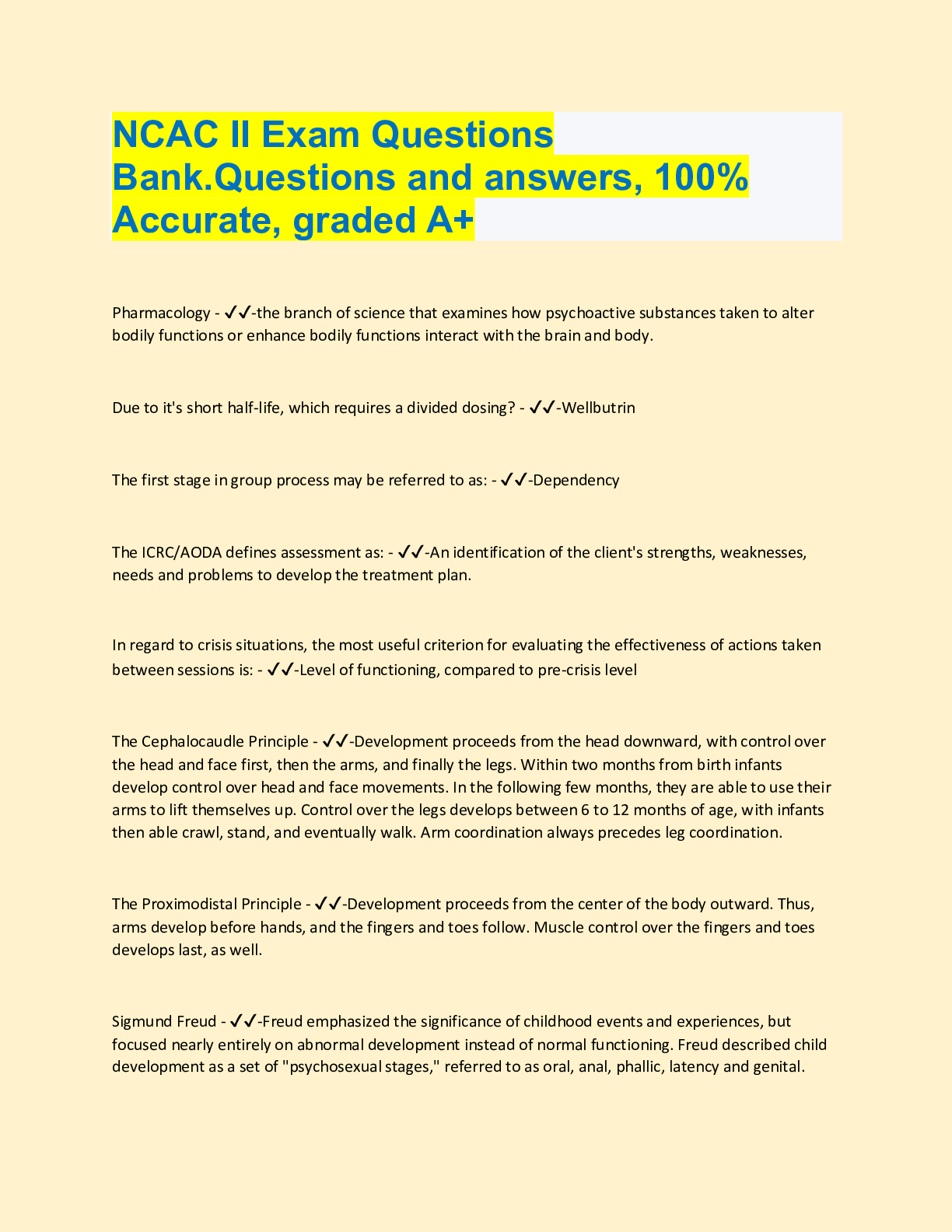
Buy this document to get the full access instantly
Instant Download Access after purchase
Buy NowInstant download
We Accept:

Also available in bundle (1)

NCAC Practice Test BUNDLE, TOP EXAM PREDICTOR QUESTIONS
NCAC Practice Test - Momentix Book, Questions with accurate answers, rated A. VERIFIED.
By Topmark 2 years ago
$36
16
Reviews( 0 )
$12.00
Can't find what you want? Try our AI powered Search
Document information
Connected school, study & course
About the document
Uploaded On
Mar 14, 2023
Number of pages
51
Written in
Additional information
This document has been written for:
Uploaded
Mar 14, 2023
Downloads
0
Views
82

